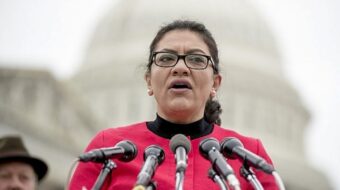Editor’s note: Excerpted from report to CPUSA National Committee November 13,
Only direct and indirect government intervention to stimulate and restructure the economy along democratic lines stands a chance of lifting the working class and nation out of the present and persistent economic morass.
The elements of such an intervention could include:
* Assist democratically elected municipal and regional authorities to plan and organize major projects;
* Channel investment dollars to small and medium sized businesses, worker/community cooperatives, and financially starved state and local governments;
* Adopt an industrial policy that will renew and convert to new uses our nation’s manufacturing sector;
* De-militarize and go over to peacetime production;
* Facilitate the formation of cooperative owned plants and workplaces, which the steelworkers are currently exploring;
* Initiate massive public works jobs for infrastructure development, environmental cleanup, and green industries, ranging from power turbines to windmills to non-polluting public transportation systems;
* Democratize the Federal Reserve system;
* Insist on the passage of EFCA and other legislation to enhance the rights and conditions of workers and communities;
* Review trade pacts, such as NAFTA, CAFTA, and others;
* Restructure global economic institutions or construct new ones that take into account the new economic and political circumstances on a global level;
* Reduce the work day with no cut in pay; raise the minimum wage; and apply consistent and robust affirmative action hiring guidelines;
* Tax capital movements, especially short-term movements that are so destabilizing to the economies of many countries;
* Shift taxes to the wealthiest individuals and corporations;
* Reform the financial sector and turn the “too big to fail” banks into public utilities under democratic control. (Many of the regulatory proposals already under consideration are positive, but some of the sticky issues like democratic control over the Federal Reserve Bank, the hyper concentration of the banking system, the future of hedge funds and equity firms, the loopholes in derivative trading, etc, are not part of the conversation. Nor is the placing of the “too big to fail” banks under public democratic control a consideration.)
The likelihood of passage of the above measures has little to do with their feasibility; it hinges by and large on the ability of working people and their allies to frame the national conversation and win active popular majorities for them.
In the 1930s, the Great Depression convinced millions of people that the old model of unrestrained capitalism was bankrupt. But it was only in the course of fierce battles that significant democratic reforms were passed.
As a result, a new set of institutions, rules, and legislation – a new model of governance, the New Deal – took deep root in our nation’s political economy and psychology.
What was missing, however, was an adequate stimulus and investment frontier to revive the economy. The Roosevelt administration was going in that direction, but under pressure changed course in the name of budget balancing (sound familiar) and the economic recovery stalled. And it wasn’t until the war mobilization that included government borrowing, industrial conversion, and national planning that that the economy fully recovered and a sustained expansion, lasting for roughly three decades, began.
Much the same combination of restructuring and re-inflating the economy, albeit in a very different circumstances, is necessary again. So far the administration has junked some of the economic assumptions and practices of neoliberalism, but much more needs to be done to re-inflate, restructure, and democratize the economy, to lift it onto a dynamic growth path. But as mentioned earlier, a full recovery and sustained growth could be an elusive goal, because economic conditions are so very different than were at the close of WW II.
In any event, the struggle for radical reforms and a new model of governance is imperative. While neither will resolve the contradictions (and its main contradiction between private appropriation and socialized production) and crisis tendencies of capitalism, both will mitigate capitalism’s impact on the conditions of life and work of working people.
Furthermore, in struggles for radical democratic restructuring the working class and its allies not only come up against the insufficiencies of capitalism, but also gain the experience, desire, and unity to transform themselves and society.
Jobs and immediate relief
A starting point is the struggle for immediate relief for victims of the economic crisis. The accent should be on action -to provide unemployment benefits to every job seeker, to open livable homeless shelters and more food pantries, to prevent evictions, to support collective bargaining and strikes, to create jobs, to build health care clinics, schools, and public and cooperative housing, to halt utility cut offs, and to aid decimated cities. Some of this is happening, but much more needs to be done.
Such actions, led by the victims of the crisis as well as mass leaders and activists in unions, churches, neighborhood and ethnic organizations, block clubs, and social groups, are the roar from below that will give an urgency to the legislative process above.
No one should be overwhelmed by the scope of the problems, or held back by the idea that mass action has to mean thousands of people. Mass is a relative term.
The labor movement can play a special role. Ditto for the churches.
Special attention should be given to the struggle for multi-racial, multi-national unity and equality – the struggle for the latter is a condition for the former.
Recently, the AFL-CIO, NAACP, National Council of La Raza, Leadership Conference on Civil Rights and the Center for Community Change rolled out a proposal for a jobs and infrastructure program. It includes five critical points:
1. Extend the lifeline for jobless workers.
2. Rebuild America’s schools, roads and energy systems.
3. Increase aid to state and local governments to maintain vital services.
4. Fund jobs in our communities.
5. Put TARP funds to work for Main Street.
The campaign for such a program can become a channel for millions of people – unemployed and employed – to become participants in the jobs struggle. It can turn frustration, isolation, and despair into action, community, and hope. And it can be a yardstick by which to measure candidates in the 2010 election.
And it can also help to strip from the extreme right their claim to be “fighting for ordinary Americans.”
This campaign should be the bread and butter of every people’s organization. No one should sit it out. While the intended effect is economic – to create jobs – it will also have a political effect, deepening, broadening, and energizing the people’s movement and in so doing, shaking up Washington.

MOST POPULAR TODAY

High Court essentially bans demonstrations, freedom of assembly in Deep South

Zionist organizations leading campaign to stop ceasefire resolutions in D.C. area

UN warns that Israel is still blocking humanitarian aid to Gaza

U.S. imperialism’s ‘ironclad’ support for Israel increases fascist danger at home







Comments